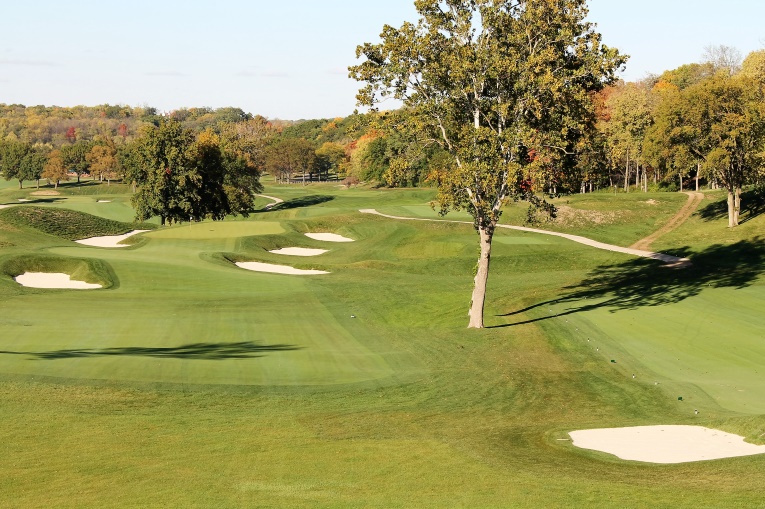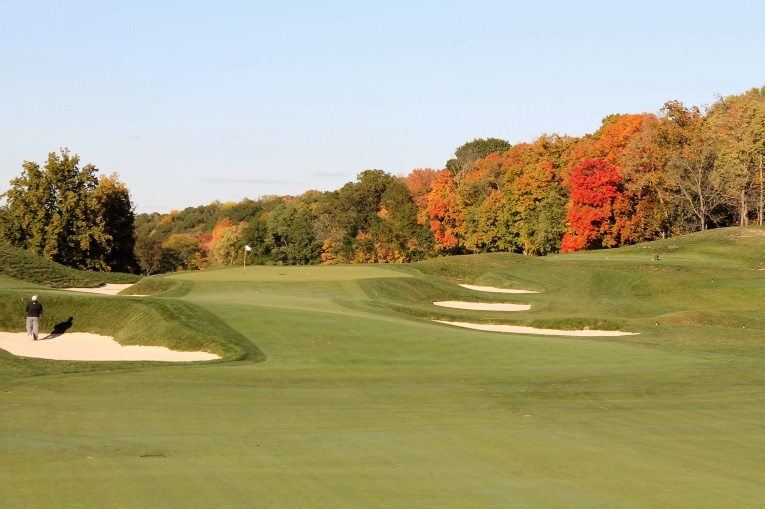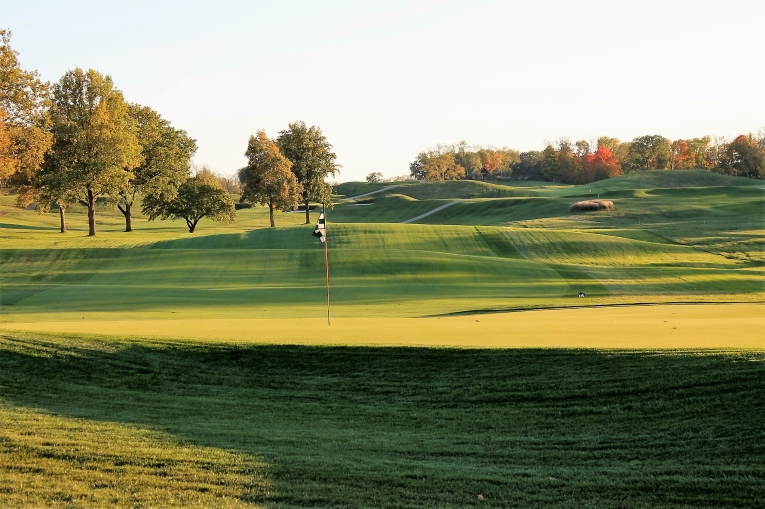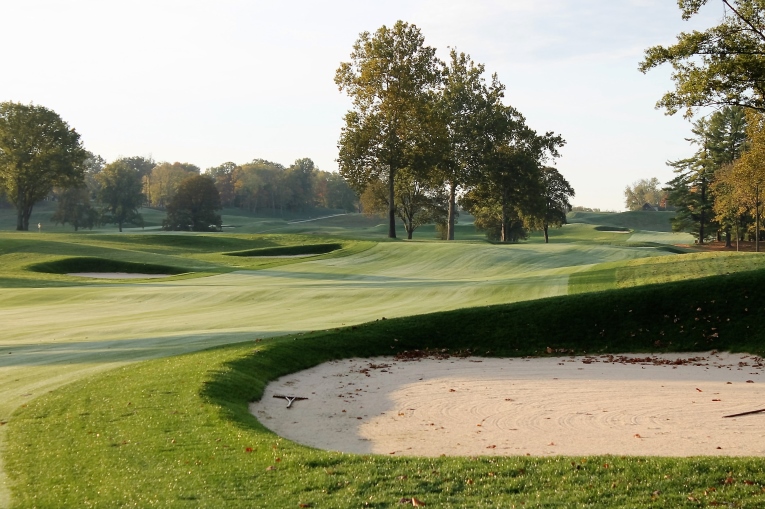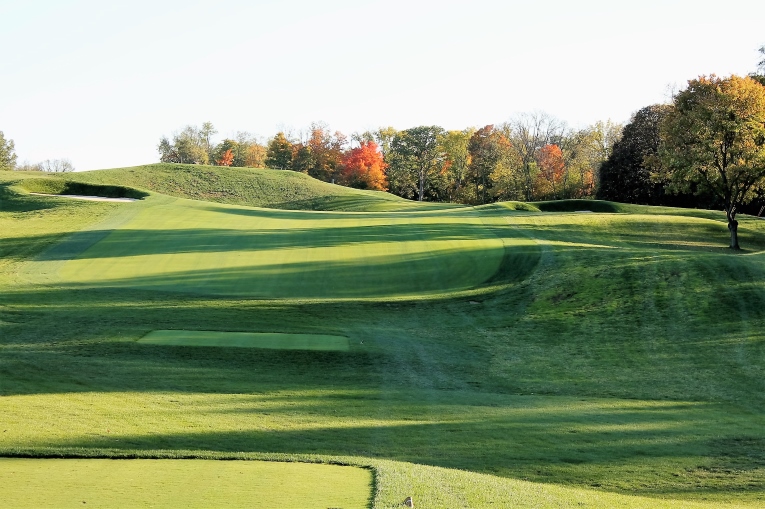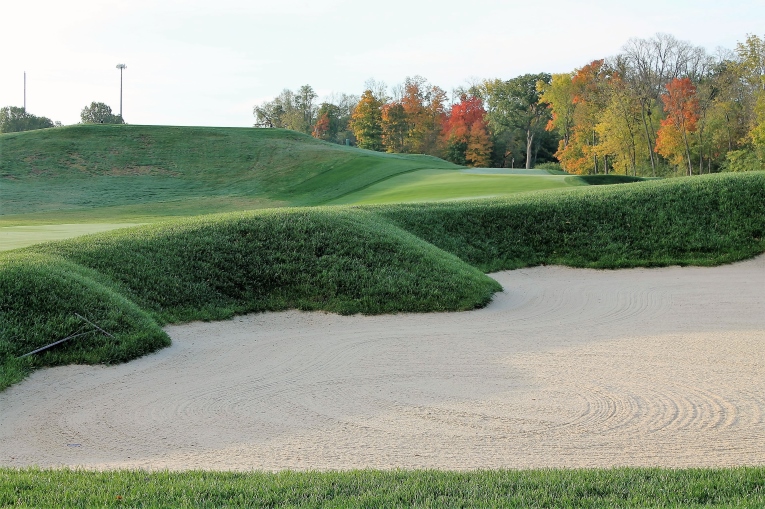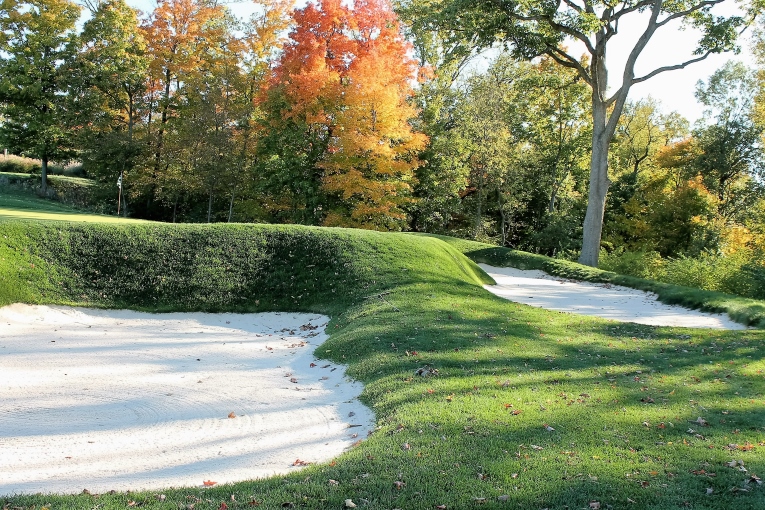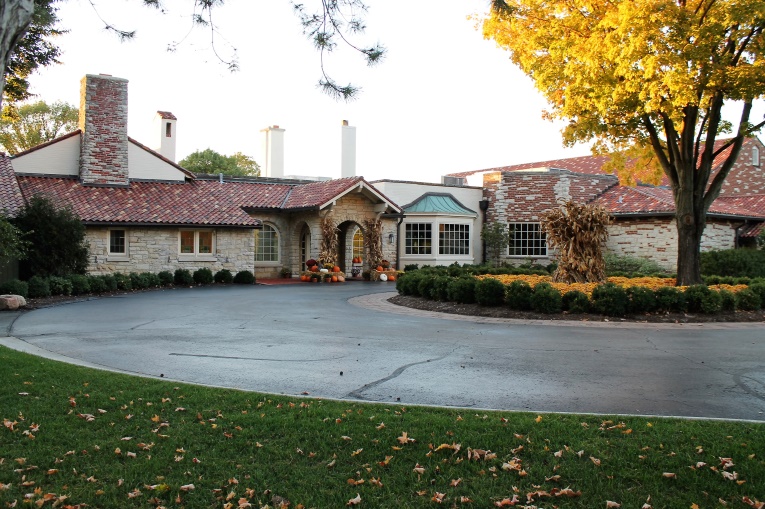Moraine Country Club
Kettering, Ohio
United States of America
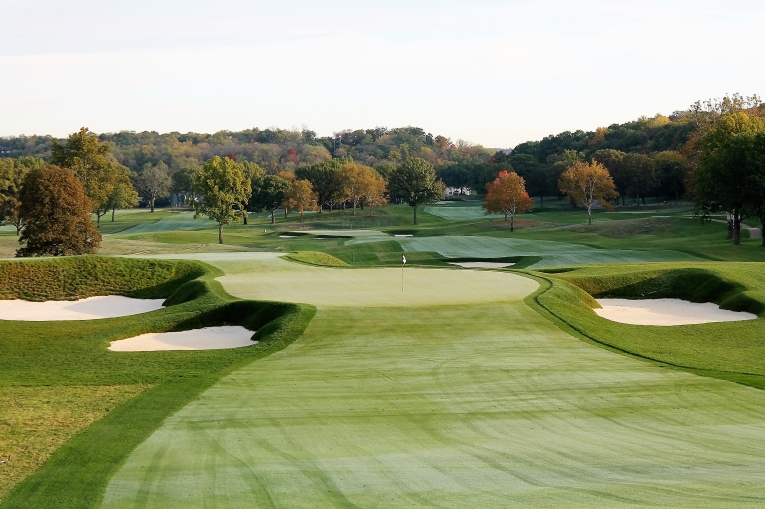
A ten year restoration project by Keith Foster has led to the dawn of a new era at Moraine Country Club.
In the fall of 2016, the golf world is a very exciting place. Exquisite work is being performed around the world to restore gems from the Golden Age of golf design. Coupled with improvements in agronomy, many of the world’s finest courses are the best they have ever been. We are fortunate to exist in these times.
One such brilliant transformation has occurred in Kettering, Ohio and the author can write that from first hand experience. I first saw the course in the fall of 1986 while employed by the United States Golf Association who was conducting a capital campaign. At the time, I helped coordinate and run such events across the country. Prestigious clubs were asked to host luncheons followed by a presentation and golf. Such an event was held at Moraine on a wet October day. After the lunch and presentation, the soggy weather shooed many of the attendees away. Only a few remaining souls battled out onto the course. On that day we were confronted by a rigorous, though straightforward parkland test. Holes were tightly framed by trees and squarely in front of the golfer. I remember the par 5 4th as it twisted uphill, the short one-shot 5th in its own secluded bowl and two very hard holes on the back but that was all.
Roll the clock forward 25 years and something curious began. People were talking about the course and a buzz was generated within the golf community. Trees were being felled and some of the game’s most scintillating inland landforms were being revealed from underneath what had become an arboretum. A renewed appreciation began to emerge about Moraine’s architect as well.
Alex ‘Nipper’ Campbell was a crack golfer (he won the Scottish Open at age 16). When he immigrated to the United States in 1896, his first port of call was Boston where he stayed at The Country Club for twenty years. There, he formed a friendship with Francis Ouimet that lasted a lifetime. Indeed, it was at Campbell’s urging that his pupil Ouimet entered – and won – the famous 1913 U.S. Open. Regaled as a great shot maker, Campbell played in the U.S. Open in four different decades and garnered five top ten finishes. He moved from Brookline to Baltimore in 1916 before coming to the Miami Valley area. He never abandoned his Scottish sensibilities and remained a staunch traditionalist his entire life, hating the advent of steel shafts and refusing to use wooden tees.
He designed several courses in the Miami Valley region but Moraine, where he served as the head professional from 1930 until 1938, was undoubtedly his masterpiece. He thought that the best holes were in his home country and was happy to ‘copy a course.’ By that he meant that he would borrow the best design elements from Troon, Prestwick and St. Andrews. One design tenet he brought over was the belief that hazards should be hazardous. Both along the fairways and greenside, Moraine features some of the deepest, most consistently steep-faced bunkers in the country. Having noted that, it should also be highlighted that Campbell didn’t believe in ‘over-populating’ a course with bunkers either. Today, sixty bunkers dot the property, which is a pittance compared to the 200 plus bunkers found at St. Andrews and Oakmont for instance. Campbell (refreshingly!) advocated that ‘courses should be built specifically for the average club member.’ At Moraine, club members are given plenty of room and short grass to negotiate the well placed hazards.
Campbell spent a decade refining his work but the backbone of the course is the routing that he nailed at the outset when construction began in 1929. His butterfly routing has the front nine tracking clockwise and the back nine loosely counterclockwise from the clubhouse. The last three holes on each nine are side by side as they tumble down from the high end of the property north toward the Mediterranean inspired, tiled roof clubhouse. The seventh and sixteenth are an unusually handsome set of shortish two-shotters; Eight and seventeen are diverse par 5s while nine and eighteen are stout two shotters whose flags are a scant 55 yards or so apart.
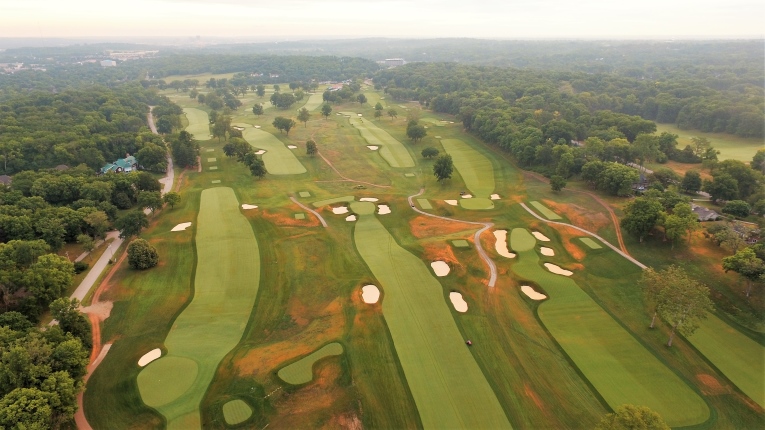
The seventh (lower right) and sixteenth holes parallel each other as they head back toward the clubhouse. The aerial masks the exceptional land movement that makes each hole – and indeed the course – so special.
Though Campbell’s routing over some dramatic landforms gives the course its inimitable flavor, all that really matters is the golf itself. Let’s pick the story up in September 2006 when Moraine was looking for a new Green Keeper. Among the applicants was Jason Mahl, an Assistant Green Keeper at Pine Valley Golf Club. As Mahl states, he ‘fell in love with the green complexes’ on his initial visit. Clearly Golden Age, the greens and their surrounds were unique; they weren’t quite like those of Ross, Tillinghast, Raynor or any other ones that Mahl had ever seen. The rest of the land felt special too, though just how remarkable remained a mystery due to the forestation of much of the club’s 160 acres.
Upon accepting the position, Mahl sent some pictures to his friend, golf architect Keith Foster, with whom he had successfully worked on a restoration at Louisville Country Club. Foster was intrigued and made the two hour drive from Paris, Kentucky. Famously finicky about accepting projects, Foster considered Moraine to be a dream opportunity in that it ticked two crucial boxes for him: the design was singular and it was so good that it could become ‘epic.’ Also, the low key charm of the club reminded him of the appealing way they go about golf in the United Kingdom. It was primarily the one off nature of the design that resonated with Foster who, for example, eschews Donald Ross projects. ‘Often times prior to visiting a course, I know a good bit about the original Architect and likely the course itself. Moraine in truth was very unexpected and therein lies part of its great charm. The club flies low under the radar which is why I love working here.’
Though this was a distinctive opportunity, Foster didn’t alter how he went about it. As he states, ‘I actually approach all my work the same. I never want to leave a heavy mark, which in the case of a Campbell design could have been dangerously easy. After all, very little is known of Campbell, so why not add to his work? And that is my point! Instead, I hoped to respect the very fine effort that Campbell had originally laid out while striving to softly execute the features and details to the best of my abilities.’
At the time, Moraine’s green committee consisted of one man, Hugh Wall. He fondly recalled the open course that existed when he was a young adult and so was simpatico to Foster’s vision of returning the course’s grand scale. Without interviewing another architect, the club hired Foster to develop a Master Plan in the fall of 2007. On a side note, the Master Plan wasn’t in that year’s budget but the Haley family, whose father was past green chairman and president, gifted the Master Plan to the club in appreciation of what the club had meant to their family.
Tree clearing began in the winter of 2007/2008 in the southwest corner of the property which is occupied by holes fourteen-sixteen. There weren’t many specimen trees but there was startling topography. Mahl recalls one light winter snowfall that in particular helped highlight the ‘awesome landforms’. Jack Proud, club president, and the rest of the board were duly impressed and though the actions taking place on the property were bold and a strong conviction was developing at the board level as to the correctness of the club’s path. Soon, Mahl was instructed to start working on the area left of the seventh green and the forest that occupied the large area between the two par fives, eight and seventeen.
Mahl’s crew worked seven days a week during that busy winter when twelve acres of largely non-indigenous, non-specimen trees were removed. The land could breathe again and holes were freshly exposed to sunshine and wind. Additionally, to help make the surfaces play as fast and firm as the Scot Campbell would like, two miles of sub-surface drainage and five sump pumps were installed near the southern end of the property.
Work continued at a measured pace and in the spring of 2009, new back tees were added to eight and fifteen. In November, 2013 the committee visited Foster’s recently completed renovation at the Philadelphia Criket Club where they were graciously hosted by the General Manager, Head Golf Professional and Green Keeper. A compelling picture emerged of what could be accomplished by going all out and not taking half-measures. Moraine’s president John Haley and Green & Restoration Chairman Ray Lane returned and convinced Moraine’s board to proceed with a complete restoration of the fairways, greens and bunkers. Moraine closed in August 2015, its fairways gassed to kill all Poa seeds and re-opened for play in June, 2016 with 007 on all tees, fairways and approaches. The greens were cored out, rebuilt to USGA standards and grassed with Pure Distinction.
As we head to the first tee, we are wise to heed the advice of Brent Sipe, the Head Golf Professional who has been at Moraine in different capacities for over four decades. His words of wisdom: ‘Never be long. Land the ball near or on the front of the greens and let it release back. Whatever you do, stay below the hole all day long and resist the temptation to fly it to back hole locations. Recovery can be readily had from just short of most of the greens but if you go over, chances for a successful up and in dwindle quickly.’
Holes to Note
First hole, 415 yards; There are many ways that a first hole can appeal. One is for it to be hidden from view, so that mystery and anticipation builds until you arrive on the tee (e.g. Castle Stuart, Royal County Down). Moraine’s is the more common variant where the arriving golfer gains awareness of the hole – and any occupants – as he drives onto the property. An old fashioned two slat rail tracks left of the fairway and the low slung Mediterranean clubhouse to the right create a cozy pocket from which play emanates. As for the hole itself, it is straight and yet not straightforward.
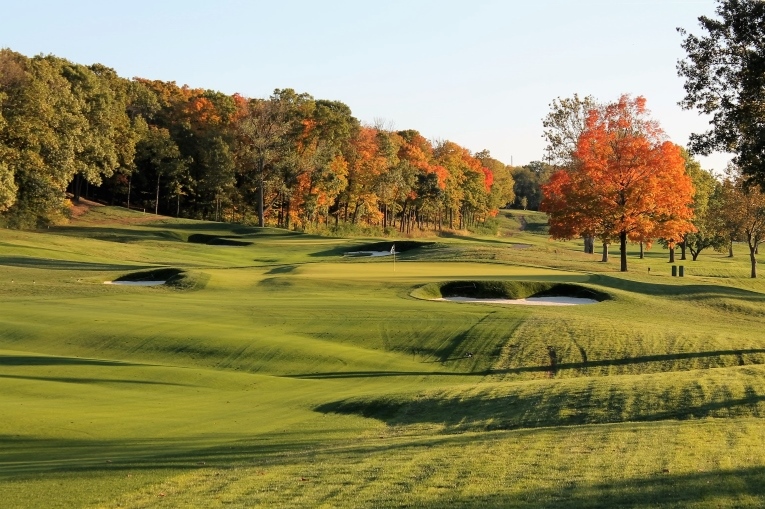
The undulating first fairway with its three to seven foot contours immediately signifies that this is singular golf country.
Second hole, 220 yards; When Moraine hosted the Ohio Amateur in 2009, this proved to be the hardest hole with its putting surface that resembled a ski slope. Foster (allegedly!) mellowed the green somewhat by propping up the front end and therefore gaining several more hole locations. Nonetheless, the green’s cant follows the natural flow of the tilted land and two-putting from either the side or above the hole remains one of the round’s toughest propositions, especially on the new Pure Distinction putting surface which Mahl can make as firm and as fast as required.
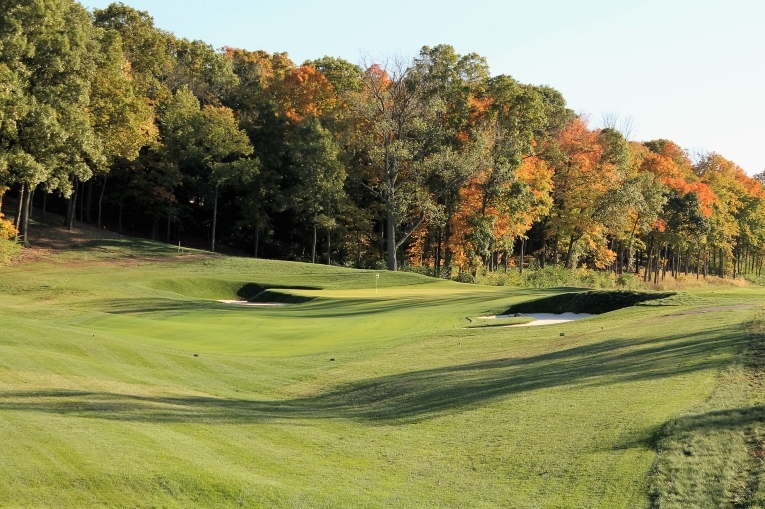
Foster restored Campbell’s crescent shaped bunker short right after studying black and white aerials. A draw over that bunker can scamper onto the open putting surface.

In the low light of the setting sun the second green may appear tranquil but is anything but as the green falls four feet from back to front. It reminds us of Sipe’s advice to play short as only a magician could get up and down from the left hand bunker to that hole location.
Fourth hole, 540 yards; This hole enjoys a love-hate relationship with the members signifying that something unusual is going on. In this case, an abrupt fifty-five foot embankment punctuates the fairway some two hundred and twenty yards from the green. Less strong players struggle to mount the hill in two and the sight of a ball cascading back down the fairway is discouraging indeed. Conversely, the tiger might be able to chase a ball onto the open green in two but won’t know his fate until he crests the hill to gain sight of the green. Shots whose outcomes are not readily apparent are more frequently found on links, making it a delight to find one so far inland.
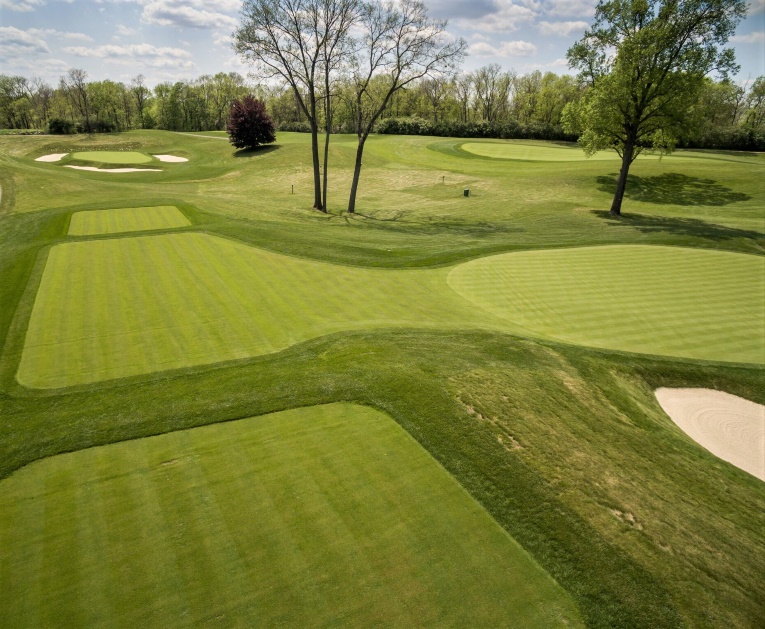
Moraine is a walker’s paradise with numerous short green to tee walks. One of the most seamless occurs after holing out at the fourth, seen right.
Fifth hole, 155 yards; Situated in its own bowl, this hole stood out when the author visited in 1986 because it wasn’t hemmed-in with trees and because all tightly-defended Short Holes are a treasure. While the hole’s do-or-die proposition remains wholly engaging the author would no longer place it among the course’s six or seven best holes. That is the extent to which so many of the holes were enhanced during the ten year Foster restoration. About the fifth Foster opines, ‘I love the routing at Moraine. It quickly escapes from the elegant clubhouse to find oneself at hole 5 at the very far end of the property and then return home. Moraine has what all great courses possess, an escape from all the cares with the ability to lose yourself within the course. That is a rare gift.’ It is worth noting that Moraine’s Short hole is the one hole on the course whereby the golfer is precluded from bouncing the ball onto the putting surface. Given that Campbell was from Troon, it would be tempting to say that its famed Postage Stamp hole greatly influenced him but there would be one problem with that: Campbell left Scotland in 1896 and the Postage Stamp wasn’t built until 1909. Campbell did periodically return home so one imagines he saw it then but there is no known record of that occurring.
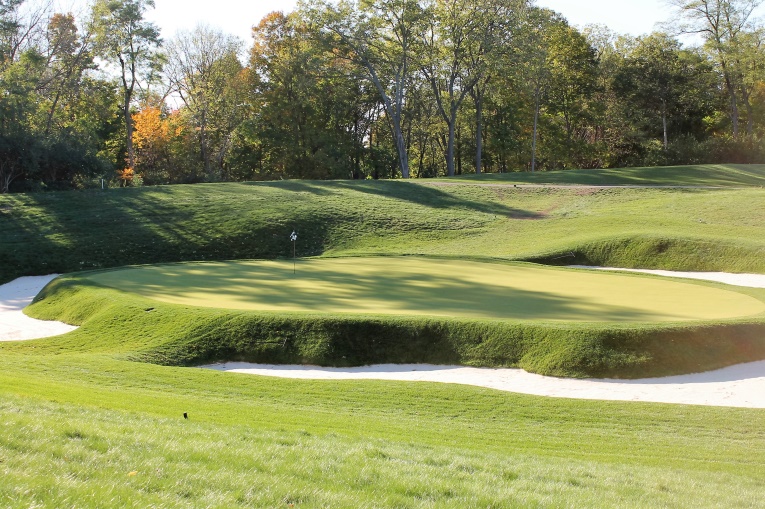
As seen from the side, charming as charming can be, the short fifth is now just one of a slew of great holes at Moraine.
Sixth hole, 360 yards; In 1986, the hole featured a delightfully rolling fairway but its greatest greatest architectural element was missing, a skyline green. Back then, the approach was played toward a canopy of trees and didn’t hold near the interest – or intimidation – that exists today as you see its flag silhouetted against the sky. Knowing that the green is perched on top of a steep embankment with a five foot deep bunker restored just over the back of the green even the best players have to think hard about chasing back left hole locations. Rear bunkers, like this one, are an interesting differentiator of Campbell’s work to some of his peers. Several of the deepest greenside bunkers (here, the fifth, sixteenth) snare balls that are long.
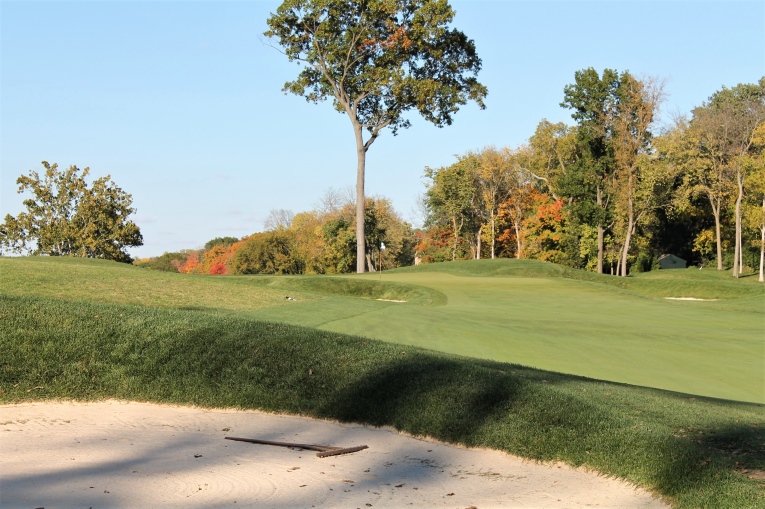
The fairway slopes well away from this high left fairway bunker and funnels tee balls to the right side of the fairway which is the ideal position to approach the green.

The same holes seen ten years prior. Encased in trees, the green was robbed of its sense of place high on a ridge.
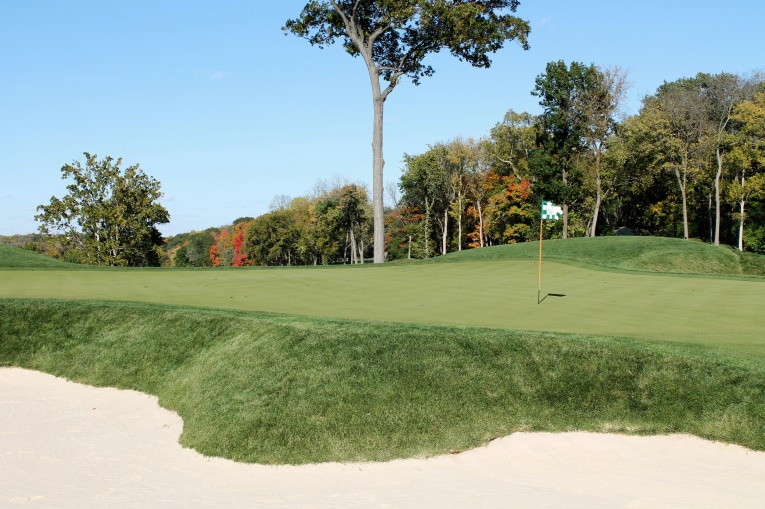
Flags at attention are much more common sights these days as the wind whistles uninterrupted through the property.
Seventh hole, 325 yards; Off the charts gorgeous, Moraine’s full glory is revealed on this elevated tee. The back tee marks the high spot of the property and from it the golfer can see more than half the holes (e.g. 2, 3, 4, 6, 7, 8, 13, 14, 15, 16 and 17), plus the bunker that separates the ninth and eighteenth greens. Dangerous thoughts of grandeur dance through the golfer’s mind making the hole more exciting than it was in Campbell’s day as technology has brought this downhill green in reach for the tiger off the tee. Conversely, experience has taught Sipe not be greedy and to always lay-up. That tactic will likely become even more popular in the coming years once the fescue grasses take hold in the area right of the green. The rub though is this: the stretch from eight through fourteen covers 3,306 yards against a miserly par of 29. If you allow 14 putts on those seven holes, the golfer is asked to cover 220 yards per shot during this stretch. Armed with the knowledge of what’s coming, most golfers (who as a lot tend to be mule headed) opt for rash and imprudent tactics off the seventh tee and swing away with the driver in hopes of glory!

Tricky hole locations abound at the seventh. Deep hole locations are challenging as the green narrows but front hole locations are no bargain either. In fact, members swear that front right is most difficult as virtually any putt is likely to be downhill and swift.
Eighth hole, 640 yards; When playing most Golden Age designs, the single most wanting aspect is generally the second shot on par 5 holes. Unless the golfer is having a crack at the green, the shot is usually little more than advancing the ball down the fairway. Moraine is different; great emphasis is attached to clearing the crest of the hill at the fourth and hillocks at the other par 5s. Here, a ridge crosses the fairway 180 yards from the green and those who approach from behind it suffer the vagaries of a blind approach. Another smaller hillock crosses 100 yards shy of the green and in the finest Scottish tradition, there is no guarantee of a level lie/stance.

Think this view of the course drapped in its autumnal colors is pretty? Wait until the native fescue program is established.
Ninth hole, 475 yards; The small puffs and pockets that dot the Moraine fairways are a thing of beauty and signify that heavy machinery has never trampled the landscape. Campbell knew only rumpled fairways (he passed away in 1942) but how pleased he would be to see these fairways today. During the 1945 PGA Championship, Bryon Nelson,the eventual champion, targeted a specific area of fairway down the right that afforded the most level lies. To this day it is called Nelson’s Flat and sits about 150 yards from the green. That PGA Championship was Nelson’s ninth win in a row.

The ninth green (near) and eighteenth green finish beside one another at the base of the club’s veranda.
Twelfth hole, 245 yards; In preparation for the 1945 PGA Championship, the twelfth green was moved about forty yards to the right from where Campbell had built it. It is unclear what year that work was completed and strong doubt about Campbell’s involvement exists, especially given that he passed away in 1942. The putting surface was sunken below the surrounding bunkers in counter distinction to every other green at Moraine. Additionally, the green was pushed against the back west boundary line defined by a creek. Over time, a thicket of trees behind the club’s property grew tall and shaded the putting surface leading to mushy, unhealthy turf. Something needed to be done. Foster went to work, pulled the green complex off the boundary and moved it some thirty yards. Fortuitously, he was also able to move the tee thirty yards closer to the prior hole’s green. In constructing a ‘new’ green, he took great care to do it in a manner consistent with Campbell’s. In the end, he accomplished what was most important, playability. And he did so ‘… without it looking like I was there. I know that we live within a world that wants recognition but to me, how wonderful that Moraine remains truly remarkable and not spoiled by my hand.’
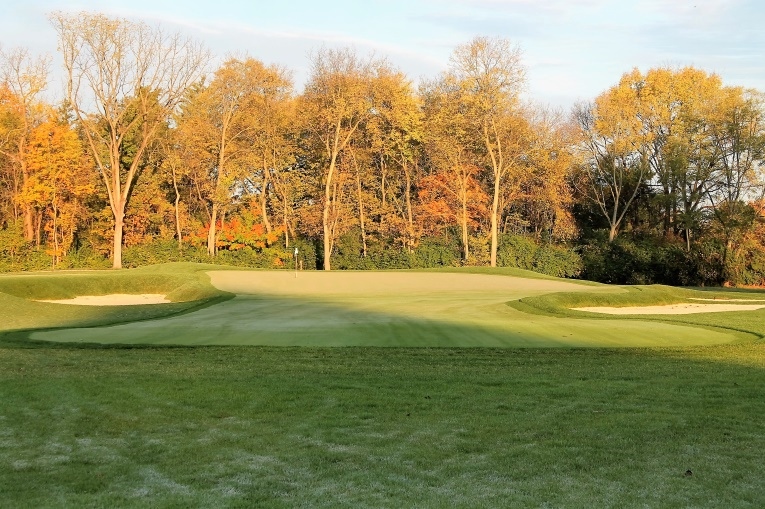
Could Campbell have built today’s green? Yes. Is the walk from the prior green shorter? Yes. Job well done, Keith Foster!
Thirteenth hole, 610 yards; Moraine possesses not one but two par fives longer than 600 yards that embody the definition of a three shot hole. While the eighth plays downhill, the thirteenth goes uphill in the opposite direction and leads the golfer out of the quieter northwest section of the property back into the rollicking hills.

The next objective is to seek the left plateau with one’s second to gain a more level stance for your third and a view of the putting surface.

A long hole that ends with a dull target can rightly be viewed as a waste of time. Not so here – Look at this delicious indentation that scoots balls right at the green.
Fourteenth hole, 455 yards; Some difficult two shotters deflate (15 at Bethpage) while others inspire (13 at Prestwick). Happily, this beast falls within the second camp. The author didn’t think so in 1986 when it was an unending, unmerciful, uphill beating through trees. Now, the rambunctious land over which this hole is laid is apparent. While the hole makes no attempt (even half-hearted) to flatter the golfer, he delights in strolling about such convoluted landforms even when the golf goes a bit askew? What’s true about Moraine that wasn’t thirty years ago is what an inspiring and uplifting a place it is to be without golf clubs.

… the golfer can devise a means to hit this green from quite a ways back. No narrative required for those that come up short left.
Fifteenth hole, 170 yards; Yardage for the prior seven holes reads 638-473-449-439-243-610-454. Yikes! Mercifully, the challenge has shifted from a premium on length + accuracy to one of accuracy + accuracy! Give Foster the lion-share of the credit for how well this one shotter plays. Dick Wilson’s efforts here in the late 1950s weren’t entirely sympathetic to Campbell’s style and Foster made the hole more striking by evoking Campbell’s steep and deep bunker style and better incorporating the ledge on the right. Foster notes that it was ‘also important to establish the close connection and walk-off from 14 green to 15 tee reminiscent of the connections at 16 – 17 and 17 -18.‘ Some members nominate the two one shotters on the back nine as the holes most improved by the restoration process.
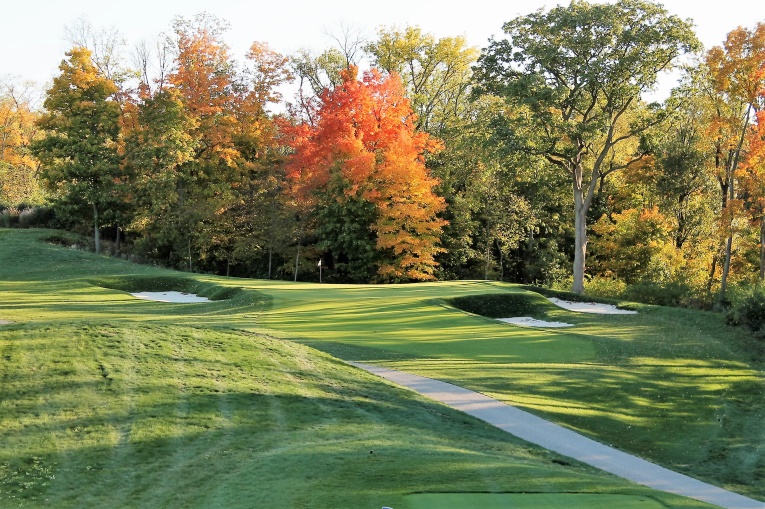
A new tee higher left changes the perspective quite a bit and affords the golfer a look at the putting surface.
Sixteenth hole, 410 yards; Campbell apparently shared a belief with Ohio’s most famous architect, Pete Dye, and tried to make short holes play shorter and long holes play longer! At the seventh and here, Campbell cascades the golfer off the high end of the property with breathtakingly shortish two shotters. This one stair-steps down, dropping the golfer thirty feet into the landing area before descending another twenty feet to the green. Seven of Moraine’s sixty bunkers are found on this hole.

A tee ball at sixteen that splits the left and right fairway bunkers will leave the golfer with a nervy pitch to a tall green pad surrounded by deep bunkers.

The sixteenth green epitomizes the targets at Moraine: open in front, well defined and bunkered at the base.
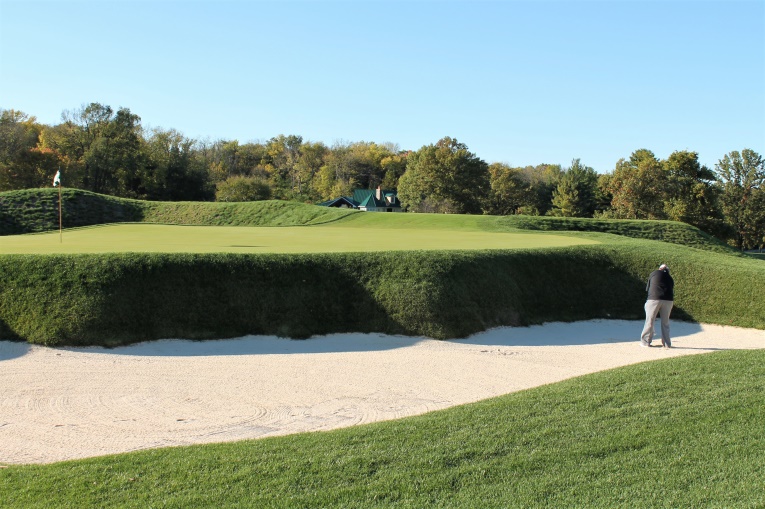
It can’t be overemphasized that the bunkers at Moraine look bonny and function well (i.e. they drain efficiently) while meting out a suitable punishment for those that stray. A 60 degree wedge is an important implement for a day at Moraine.
Seventeenth hole, 470 yards; On this 1/2 par hole the elevated tee lends a false sense of comfort to the golfer who may actually think that he is – finally – in control. Once down in the hitting area, the table is turned by a diagonal ridge 200 yards short of the green that blocks the view. A golfer who launches his three wood at the green, does so with trepidation, knowing that one of the deepest greenside bunkers is front right.

The penultimate hole seems cheery and simple from the elevated tee where the golfer can readily discern that right center is the ideal position from which to approach the green in two.

It gets progressively more complicated in the fairway. A Scot thru and thru, and heavily influenced by Prestwick and Troon, Campbell had no compunction about incorporating the occasional blind shot. A tree on the horizon becomes an aiming point.

Can the golfer chase the long, blind approach through the gap, onto the green? A pull is better than a push as the left bunker is only half as deep as the right. Only here does Sipe amend his advice: being long is not so bad.
Eighteenth hole, 480 yards; A first timer expecting the course to stumble coming home finds this beauty. In many ways the pacing of finish – a short iron approach at sixteen, a birdiable three shotter and a stout par 4 reminds the author of another world top 50 course – Notts Golf Club in England. Both may not be widely seen but are superlative examples of how golf can be simultaneously inspiring and challenging. They leave countless better known courses for dead.
A creek weaves forty yards in front of the tenth green but otherwise, there is no water on the course. Challenge stems from the land, deep bunkers and sloped putting surfaces. Lost balls aren’t an issue and recovery is always possible. It’s 7,270 yards from the back markers but none of the distance seems contrived as the green-to-tee walks are reasonable with some being no more than fifteen paces. The Blue tees knock off 500 yards from that gruesome set and the Whites twice that and are a siren for this Odyssey. Here’s the thing: the green complexes as restored and enhanced by Foster are so good that the course doesn’t need length. With it though, Moraine can fascinate both the tiger and high-handicapper alike.
Moraine is the best of both worlds and Alex Campbell deserves recognition for creating one of America’s finest courses. Campbell, speaking of golf later in life remarked, ‘I’ll not quit until they cover me over.’ Well, Keith Foster has uncovered Campbell’s masterpiece giving him a new voice that resonates loud and clear.
Let’s leave the last words to Foster, ‘Moraine is to me what a golf club should be. Great land, unexpected holes with a caring and gracious membership. Most importantly, there is a quiet boldness to Moraine that is seldom seen.’






